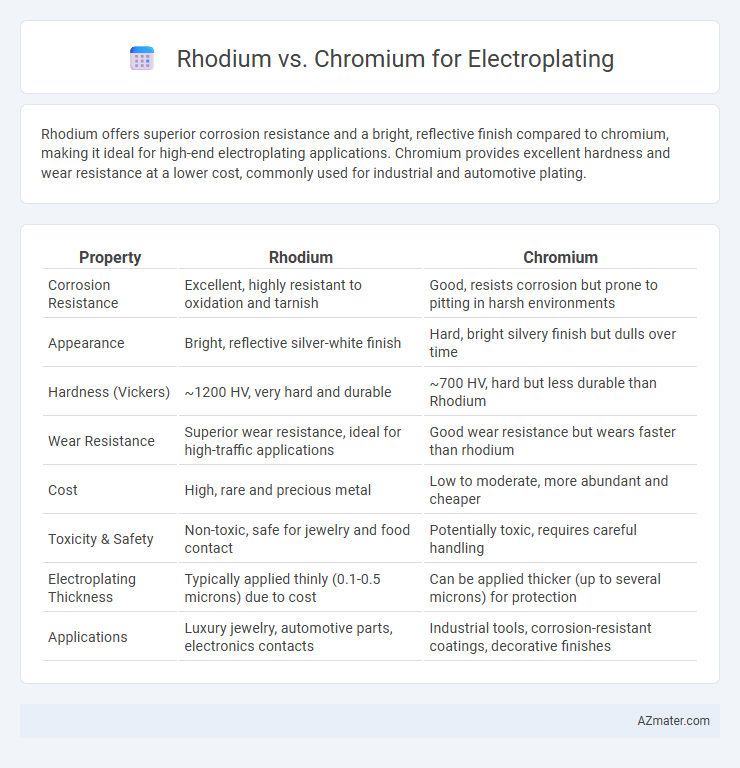Rhodium offers superior corrosion resistance and a bright, reflective finish compared to chromium, making it ideal for high-end electroplating applications. Chromium provides excellent hardness and wear resistance at a lower cost, commonly used for industrial and automotive plating.
Table of Comparison
| Property | Rhodium | Chromium |
|---|---|---|
| Corrosion Resistance | Excellent, highly resistant to oxidation and tarnish | Good, resists corrosion but prone to pitting in harsh environments |
| Appearance | Bright, reflective silver-white finish | Hard, bright silvery finish but dulls over time |
| Hardness (Vickers) | ~1200 HV, very hard and durable | ~700 HV, hard but less durable than Rhodium |
| Wear Resistance | Superior wear resistance, ideal for high-traffic applications | Good wear resistance but wears faster than rhodium |
| Cost | High, rare and precious metal | Low to moderate, more abundant and cheaper |
| Toxicity & Safety | Non-toxic, safe for jewelry and food contact | Potentially toxic, requires careful handling |
| Electroplating Thickness | Typically applied thinly (0.1-0.5 microns) due to cost | Can be applied thicker (up to several microns) for protection |
| Applications | Luxury jewelry, automotive parts, electronics contacts | Industrial tools, corrosion-resistant coatings, decorative finishes |
Introduction to Electroplating
Electroplating uses electric current to deposit a thin metallic layer, enhancing surface properties like corrosion resistance and appearance. Rhodium offers superior reflectivity and hardness, making it ideal for high-end jewelry and automotive trims, while chromium provides excellent wear resistance and affordability for industrial applications. The choice between rhodium and chromium depends on factors such as cost, desired finish, and application-specific durability requirements.
Overview of Rhodium and Chromium
Rhodium and chromium are widely used metals in electroplating due to their unique properties and applications. Rhodium, a rare and precious metal from the platinum group, offers exceptional corrosion resistance, high reflectivity, and excellent hardness, making it ideal for jewelry and automotive parts. Chromium, more abundant and cost-effective, provides strong wear resistance, a bright metallic finish, and superior hardness, commonly used in decorative and industrial coatings.
Chemical Properties Comparison
Rhodium exhibits exceptional corrosion resistance and a high melting point of 1964degC, making it ideal for durable electroplating applications requiring superior wear resistance. Chromium, with a melting point of 1907degC and notable hardness, provides excellent oxidation resistance and a bright, reflective finish in plating. Both metals form passive oxide layers enhancing corrosion protection, but rhodium's greater chemical inertness leads to longer-lasting coatings in harsh environments.
Electroplating Process Differences
Rhodium electroplating uses a complex solution of rhodium salts and requires a precise balance of current density and temperature to achieve a bright, corrosion-resistant finish with exceptional hardness. Chromium electroplating typically employs a hexavalent or trivalent chromium bath, where the process involves higher voltage and longer plating times to form a durable, decorative, and wear-resistant layer. The key electroplating difference lies in rhodium's thinner, more reflective coating ideal for fine jewelry and electronics, whereas chromium's thicker deposits suit automotive and industrial applications.
Aesthetic and Visual Outcomes
Rhodium electroplating offers a brilliant, mirror-like finish with exceptional brightness and a highly reflective surface, making it ideal for enhancing the visual appeal of jewelry and luxury items. Chromium plating provides a durable, sleek metallic sheen with a slightly darker tone, favored for automotive parts and hardware where a modern, industrial aesthetic is desired. Both metals resist tarnishing, but rhodium's cooler silvery-white appearance contrasts with chromium's warmer gray hues, allowing designers to choose based on desired visual impact.
Corrosion and Wear Resistance
Rhodium exhibits superior corrosion resistance compared to chromium, making it ideal for applications requiring long-lasting protection against oxidation and tarnish. In terms of wear resistance, rhodium provides a harder, more durable surface that withstands abrasion better than chromium coatings. This makes rhodium electroplating the preferred choice for high-wear environments where both corrosion resistance and surface durability are critical.
Cost and Market Availability
Rhodium plating offers superior corrosion resistance and a brilliant finish but commands a significantly higher cost due to its rarity and complex extraction process, with market prices often exceeding $10,000 per ounce. Chromium, more abundant and affordable, typically costs a fraction of rhodium, making it a preferred choice for large-scale industrial electroplating applications despite a less prestigious appearance. Market availability for chromium remains stable with consistent production, whereas rhodium supply is volatile, influenced heavily by mining outputs and geopolitical factors in key producing regions like South Africa.
Environmental and Safety Considerations
Rhodium electroplating offers significant environmental advantages over chromium, as it uses less toxic chemicals and generates fewer hazardous byproducts, reducing risks for workers and surrounding ecosystems. Chromium plating involves hexavalent chromium compounds, which are highly toxic, carcinogenic, and subject to strict regulatory controls due to their environmental persistence and health hazards. Choosing rhodium improves workplace safety and minimizes environmental impact while maintaining corrosion resistance and aesthetic appeal.
Common Industrial and Consumer Applications
Rhodium and chromium are both widely used in electroplating for enhancing durability and aesthetic appeal in automotive and jewelry industries. Rhodium plating is favored for high-end jewelry and electrical contacts due to its exceptional corrosion resistance and brilliant white finish. Chromium plating is common in automotive parts, plumbing fixtures, and household appliances for its hardness, wear resistance, and cost-effectiveness.
Choosing the Right Metal for Electroplating
Rhodium outperforms chromium in electroplating due to its superior corrosion resistance and brilliant white finish, making it ideal for high-end jewelry and automotive trim. Chromium offers excellent hardness and durability at a lower cost, often favored for industrial applications and decorative surfaces with heavy wear. Selecting the right metal depends on balancing aesthetic appeal, wear resistance, and budget constraints specific to the electroplated product's use case.

Infographic: Rhodium vs Chromium for Electroplating
 azmater.com
azmater.com